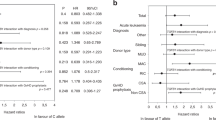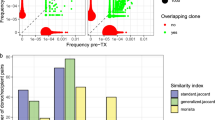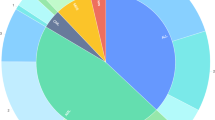Abstract
Toll-like receptor 9 (TLR9) is part of the innate immune system, which is activated by CpG oligonucleotides (ODNs) and produces potent Th1-type innate and adaptive immune responses. It is reported that TLR9 gene variants, T1486C and T1237C, are associated with a reduced TLR9 expression compared with the wild-type gene. In two cohort analyses, we evaluated the influence of these gene variants on the outcome of transplant in 413 patients and donors. A retrospective analysis of the first cohort (n=293) showed that the homozygous CC gene variant of TLR9 (1486) compared with TC/TT gene variants was significantly associated with a markedly improved 5-year TRM (11.7 versus 36.4%, P<0.003), 5-year OS (86.1 vs 48.3%, P<0.001) and a lower relapse rate (13.2 vs 33.3%, P<0.007), whereas the occurrence of acute GVHD was not different. A prospectively performed analysis of the second cohort (n=120) and multivariate analyses confirmed the influence of the CC gene variant on these end points. Compared with patients with TC/TT gene at position 1486 of TLR9, patients with the homozygous CC gene variant had a lower TLR9 mRNA expression and a delayed T-cell immune reconstitution after transplant, which might prevent them from overwhelming immune responses as sepsis or systemic inflammatory response syndrome (SIRS) associated with an increased TRM. In vitro studies using CpG-rich ODNs showed an upregulation of TLR9 expression in cell lines with CC gene variant, but not in cell lines with wild-type gene.
This is a preview of subscription content, access via your institution
Access options
Subscribe to this journal
Receive 12 print issues and online access
$259.00 per year
only $21.58 per issue
Buy this article
- Purchase on Springer Link
- Instant access to full article PDF
Prices may be subject to local taxes which are calculated during checkout




Similar content being viewed by others
References
Medzhitov R . Toll-like receptors and innate immunity. Nat Rev Immunol 2001; 1: 135–145 (review).
Medzhitov R, Janeway Jr C . The Toll receptor family and microbial recognition. Trends Microbiol 2000; 8: 452–456.
Chiffoleau E, Heslan J-M, Heslan M, Louvet C, Condamine T, Cuturi M-C . TLR9 ligand enhances proliferation of rat CD4+ T cell and modulates suppressive activity mediated by CD4+ CD25+ T cell. Int Immunol 2007; 19: 193–201.
Li J, Song W, Czerwinski DK, Varghese B, Uematsu S, Akira S et al. Lymphoma Immunotherapy with CpG oligodeoxynucleotides Requires TLR9 Either in the Host or in the Tumor Itself. J Immunol 2007; 179: 2493–2500.
Duramad O, Fearon KL, Chang B, Chan JH, Gregorio J, Coffman RL et al Inhibitors of TLR-9 act on multiple cell subsets in mouse and man in vitro and prevent death in vivo from systemic inflammation. J. Immunol 2005; 174: 5193–5200.
Latz E, Verma A, Visintin A, Gong M, Sirois CM, Klein DCG et al. Ligand-induced conformational changes allosterically activate Toll-like receptor 9. Nat Immunol 2007; 8: 772–779.
Ashman RF, Goeken, JA, Drahos J, Lenert P . Sequence requirements for oligodeoxyribonucleotide inhibitory activity. Int Immunol 2005; 17: 411–420.
Krieg AM . Toll-like receptor 9 (TLR9) agonists in the treatment of cancer. Oncogene 2008; 27: 161–167.
Lin M-T, Storer B, Martin PJ, Tseng L-H, Gooley T, Chen P-J et al. Relation of an interleukin-10 promotor polymorphism to graft-versus-host disease and survival after hematopoietic cell transplantation. N Engl J Med 2003; 349: 2201–2210.
Elmaagacli AH, Koldehoff M, Hindahl H, Trenschel R, Peceny R, Ottinger H et al. Mutations in innate immune system NOD2/CARD 15 and TLR-4 (Thr399Ile) genes influence the risk for severe acute GVHD in patients who underwent an allogeneic transplantation. Transplantation 2006; 81: 247–254.
Elmaagacli AH, Koldehoff M, Steckel NK, Trenschel R, Ottinger H, Beelen DW . Cytochrome P450 2C19 loss-of-function polymorphism is associated with an increased treatment-related mortality in patients undergoing allogeneic transplantation. Bone Marrow Transplant 2007; 40: 659–664.
Elmaagacli AH, Koldehoff M, Landt O, Beelen DW . Relation of an Interleukin-23 Receptor gene polymorphism to Graft-versus-Host Disease after Hematopoietic-Cell Transplantation. Bone Marrow Transplant 2008; 41: 821–826.
Tao K, Fujii M, Tsukumo S-I, Maekawa Y, Kishihara K, Kimoto Y et al. Genetic variations of Toll-like receptor 9 predispose to systemic lupus erythematosus in Japanese population. Ann Rheum Dis 2007; 66: 905–909.
Berghöfer B, Frommer T, König IR, Ziegler A, Chakrabortyz T, Bein G et al. Common human Toll-like receptor 9 polymorphisms and haplotypes: association with atopy and functional relevance. Clin Exp Allergy 2005; 35: 1147–1154.
Novak N, Yu C-F, Bussmann C, Maintz L, Peng W-M, Hart J et al. Putative association of a TLR9 promoter polymorphism with atopic eczema. Allergy 2007; 62: 766–772.
Ottinger HD, Ferencik S, Beelen DW, Lindemann M, Peceny R, Elmaagacli AH et al. Hematopoietic stem cell transplantation: contrasting the outcome of transplantations from HLA-identical siblings, partially HLA-mismatched unrelated donors. Blood 2003; 102: 1131.
Elmaagacli AH, Basoglu S, Peceny R, Trenschel R, Ottinger H, Lollert A et al. Improved disease-free-survival after transplantation of peripheral blood stem cells as compared to bone marrow from HLA-identical unrelated donors in patients with first chronic phase chronic myeloid leukemia. Blood 2002; 99: 1130–1135.
Maniatis T, Fritsch EF, Sambrook J . Molecular Cloning . A Laboratory Manual. Cold Spring Harbor Laboratory Press, 1982.
Hamann L, Hamprecht A, Gomma A, Schumann RR . Rapid and inexpensive real-time PCR for genotyping functional polymorphisms within the Toll-like receptor-2, -4, -9 genes. J Immunol Methods 2004; 285: 281–291.
Elmaagacli AH, Freist A, Hahn M, Opalka B, Seeber S, Schaefer UW et al. Estimating the relapse stage in chronic myeloid leukaemia patients after allogeneic stem cell transplantation by the amount of bcr-abl fusion transcripts detected using a new real-time polymerase chain reaction method. B J Haemtol 2001; 113: 1072–1075.
Steckel N, Koldehoff M, Ditschkowski M, Beelen DW, Elmaagacli AH . Use of the activating gene mutation of the tyrosine kinase (VAL617Phe) JAK2 as a minimal residual disease marker in patients with myelofibrosis with myeloid metaplasia after allogeneic stem cell transplantation. Transplantation 2007; 83: 1518–1520.
Satoh, Akatsu T, Ishikawa Y, Minami Y, Takahashi Y, Nakamura M . Association between toll-like receptor 8 expression and adverse clinical outcomes in patients with enterovirus-associated dilated cardiomyopathy. Am Heart J 2007; 154: 581–588.
Ottinger HD, Beelen DW, Scheulen B, Schaefer UW, Grosse-Wilde H . Improved immune reconstitution after allotransplantation of peripheral blood stem cells instead of bone marrow. Blood 1996; 88: 2775–2779.
Prezpiorka D, Weisdorf D, Martin P, Klingemann HG, Beatty P, Hows J et al. 1994 Consensus conference on acute GVHD Grading. Bone Marrow Transplant 1995; 15: 825–828.
Sullivan KM, Agura E, Anasetti C, Appelbaum D, Badger C, Barman S et al. Chronic graft-versus-host-disease and other late complications of bone marrow transplantation. Semin Hematol 1991; 28: 250–259.
Kaplan EL, Meier P . Non-parametric estimation from incomplete observations. J Am Stat Assoc 1958; 53: 457–481.
Cox DR . Regression models and life-tables. J R Stat Soc 1972; 34: 187.
Calcaterra C, Sfondrini L, Rossigni A, Sommaria M, Rumio C, Me'nard S, Balsari A . Critical Role of TLR9 in Acute Graft-versus-Host Disease. J of Immunol 2008; 181: 6132–6139.
Einsele H, Ehninger G, Steidle M, Fischer I, Bihler S, Gerneth F et al. Lymphocytopenia as an unfavorable prognostic factor in patients with cytomegalovirus infection after bone marrow transplantation. Blood 1993; 82: 1672–1678.
Blazar BR, Krieg AM, Taylor PA . Synthetic unmethylated cytosine-phosphate-guanosine oligodeoxynucleotides are potent stimulators of antileukemia responses in naive and bone marrow transplant recipients. Blood 2001; 98: 1217–1225.
Jiang W, Lederman MM, Harding CV, Rodriguez B, Mohner RJ, Sieg SF . TLR9 stimulation drives naive B cells to proliferate and to attain enhanced antigen presenting function. Eur J Immunol 2007; 37: 2205–2213.
Acknowledgements
We thank Silke Gottwald and Christiane Schary (both form Essen, Germany) for their excellent technical assistance with genotyping analyses. This study was supported by grants from the Deutsche Krebshilfe, Deutsche Josè Carreras-Leukämie-Stiftung and Kulturstiftung Essen. Contributions: The first author designed and performed the research and also wrote the paper. Michael Koldehoff collected the data, performed the research and approved the paper. Dierich W Beelen collected patient data and approved the paper.
Author information
Authors and Affiliations
Corresponding author
Rights and permissions
About this article
Cite this article
Elmaagacli, A., Koldehoff, M. & Beelen, D. Improved outcome of hematopoietic SCT in patients with homozygous gene variant of Toll-like receptor 9. Bone Marrow Transplant 44, 295–302 (2009). https://doi.org/10.1038/bmt.2009.32
Received:
Revised:
Accepted:
Published:
Issue Date:
DOI: https://doi.org/10.1038/bmt.2009.32
Keywords
This article is cited by
-
Targeting Toll-Like Receptors for Cancer Therapy
Targeted Oncology (2018)
-
Sensing danger: toll-like receptors and outcome in allogeneic hematopoietic stem cell transplantation
Bone Marrow Transplantation (2017)
-
Intestinal barrier loss as a critical pathogenic link between inflammatory bowel disease and graft-versus-host disease
Mucosal Immunology (2015)
-
A non-interventional study of the genetic polymorphisms of NOD2 associated with increased mortality in non-alcoholic liver transplant patients
BMC Gastroenterology (2014)
-
Donor TLR9 gene tagSNPs influence susceptibility to aGVHD and CMV reactivation in the allo-HSCT setting without polymorphisms in the TLR4 and NOD2 genes
Bone Marrow Transplantation (2014)



